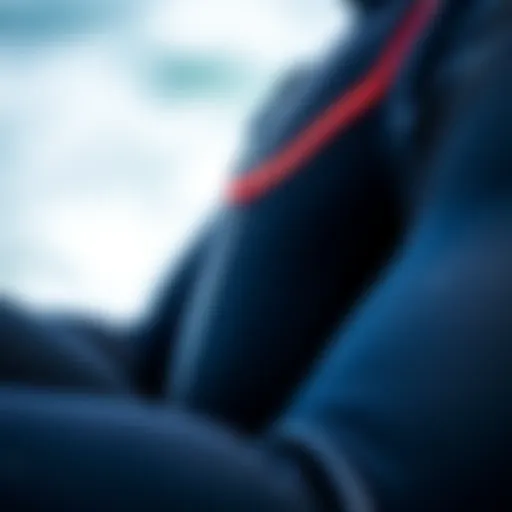Choosing the Right Kiteboard: A Comprehensive Guide
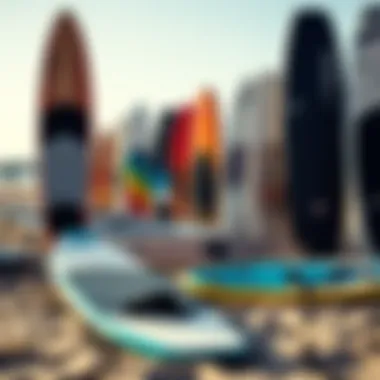
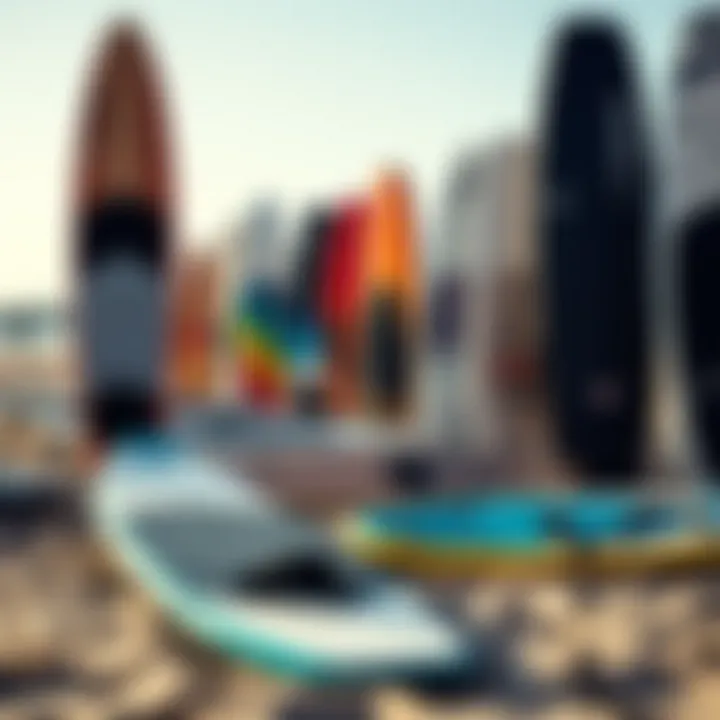
Intro
Navigating the vast waters of kiteboarding can be both thrilling and daunting, especially when it comes to selecting the right equipment. The kiteboard, a fundamental piece of gear, plays a significant role in ensuring an enjoyable experience. In a sport where the right choice can mean the difference between soaring high above the waves or struggling against them, understanding the nuances of kiteboards is essential.
From the width and length of the board to the material it’s crafted from, every detail holds weight. This guide aims to demystify the process of selecting a kiteboard and ensure that both newcomers and seasoned pros can find something that suits their style and skill level.
The following sections will explore the key factors involved in choosing a kiteboard, with a focus on gear insights, the techniques you can master, and some vital tips for safety and performance. This overview acts as a compass for kiteboarders setting out on their adventures.
Gear Insights
When it comes to kiteboarding, being equipped with the right gear can set the stage for an exhilarating experience. In this section, we’ll look into the various aspects that can help you make an informed choice.
Latest Gear Reviews
With a constantly evolving market, recent developments have introduced several innovative kiteboards designed to cater to varying preferences.
- RRD Vision: Known for its stability and versatility, this board excels in a range of conditions, from flat water to choppy seas.
- Slingshot Crisis: A fantastic option for beginner to intermediate riders. It has a forgiving shape making it perfect for those just mastering their skills.
- Naish Pivot: This one shines in performance, especially for advanced riders who like to explore their boundaries.
Keeping up with gear reviews can offer insights into which boards are garnering positive attention within the kiteboarding community. Checking forums like Reddit or dedicated kiteboarding websites can provide valuable feedback from users.
Essential Gear for Beginners
If you’re just starting out in the world of kiteboarding, selecting the right gear can feel like picking apples in a barrel. You’ll want to ensure that you choose options that align with your learning curve. Here’s a quick list of essentials:
- Kiteboard: Opt for something that balances stability and control. A wider board can help with balance, especially in the early days.
- Kite: Start with a kite that has a lower aspect ratio as it’s easier to control and launch.
- Harness: A comfortable harness is crucial for minimizing fatigue during your sessions. Look for one that fits snugly without pinching.
- Safety Leash: Always prioritize safety! A good leash can keep you connected to your kite in case of a mishap.
"The best decision a beginner can make is to find a reputable instructor for personal guidance; it saves time and enhances your skills!"
Techniques and Tips
As you progress in kiteboarding, solid techniques and safety practices can greatly contribute to your enjoyment and performance. This section highlights essential strategies for both novice and experienced riders.
Advanced Tricks and Techniques
For those looking to up their game, mastering advanced tricks can take your kiteboarding to new heights. Techniques such as a downloop transition or a kite loop can add flair to your sessions. Remember, practice makes perfect – but take your time!
Safety Practices for Kiteboarders
While kiteboarding can be exhilarating, it’s important to recognize the risks involved. There are some core practices to ensure safety on the water:
- Always assess weather conditions before heading out.
- Use a personal flotation device, particularly when you're still getting the hang of things.
- Stay clear of busy areas populated with swimmers or boats.
In summary, whether you’re diving into the details of gear or brushing up on safety and techniques, every kiteboard is unique, just like the rider.
For more detailed information, you can check out resources like Wikipedia or Britannica for comprehensive overviews and history of the sport.
Understanding Kiteboarding
Kiteboarding, a sport that combines aspects of surfing, windsurfing, and paragliding, has gained a considerable following globally. Grasping the nuances of kiteboarding is pivotal, especially when selecting the optimal kiteboard for one’s needs. Riders, whether novices or seasoned veterans, benefit significantly when they comprehend how the sport operates, its evolution, and its current standing in the outdoor adventure world.
The importance of this understanding lies not just in the technical skills required but also in the safety and enjoyment that arise from knowing how best to approach the exhilarating ride.
History of Kiteboarding
The history of kiteboarding traces back to the late 1970s when pioneers like Dewey Weber and others experimented with surfboards alongside parachute-like kites. The initial attempts were rudimentary, often seen as mere novelties. However, by the 1990s, improvements in kite materials and designs led to the establishment of kiteboarding as a recognized sport. Riders began to harness this aerodynamic art form, leading to the vibrant culture we see today.
In its infancy, kiteboarding was limited in participation due to the hazards and lack of knowledge surrounding it. Yet, as kite manufacturers, such as Naish and Cabrinha, started producing more reliable kites, the barriers began to dissipate. Nowadays, festivals and competitions around the globe serve to celebrate the sport's growing popularity, highlighting that the passion for kiteboarding spans far and wide.
Popularity and Growth
The growth trajectory of kiteboarding has been remarkable. Initially slow, the sport burgeoned, particularly from the early 2000s onwards. What was once an underground pursuit is now mainstream, with millions taking to the waves. This upward trend can be attributed to several factors: the accessibility of lessons, the variety of equipment options, and a thriving community of enthusiasts sharing tips and experiences through platforms like Reddit and Facebook.
- Accessibility: Schools popping up beachside make it easier than ever for newcomers to learn.
- Equipment Variety: With numerous types of kites and boards available, riders can find gear tailored to their style and skill level.
- Community Involvement: Online forums help share the love for the sport, allowing gear tips, travel stories, and event announcements to flourish.
Kiteboarding's allure lies in its blend of thrill and technique. Surfers enjoy the rush, while onlookers are captivated by the graceful arcs and jumps created in the air. Moreover, as awareness of the sport grows, events entice potential new kiteboarders, promoting local tourism in kiteboarding hotspots. As kiteboarding continues to evolve, it’s clear that understanding these foundational aspects will aid riders in their journey, allowing them to navigate waters in the best possible way.
"A kiteboard isn’t just a piece of equipment; it’s an extension of a rider's identity on the water."
In summary, the understanding of kiteboarding and its history, as well as its rising popularity, enriches one’s experience in choosing the optimal kiteboard. This foundation provides insights necessary to appreciate not just the mechanics of the sport, but also the community and culture built around it.
Components of Kiteboarding Gear
Understanding the components of kiteboarding gear is crucial for anyone looking to take their skills and enjoyment to the next level. Kiteboarding is not just about the kite and board — every piece of equipment plays a significant role in your overall performance, safety, and experience on the water. By grasping the importance of each component, kiteboarders can make informed decisions that enhance their riding experience.
The Role of the Kiteboard
The kiteboard acts as the link between you and the water, providing both balance and control. Its design and construction can highly influence your riding style, whether you prefer freeride, freestyle, or wave riding. A kiteboard’s width, length, and rocker shape dictate how it performs under different conditions. For instance, a board with more rocker might excel in choppy waters by providing better maneuverability, while a flatter board could offer increased speed on flat surfaces.
In essence, the kiteboard is integral to your ride, as it dictates how responsive and stable you’ll feel while carving through waves or cruising along the shore.
Essential Accompanying Equipment
When gearing up for kiteboarding, numerous essential components must accompany your kiteboard to ensure a seamless experience. Without these, your performance can be severely hindered.
Control Bars
The control bar is an indispensable piece of gear. This component allows you to maneuver the kite, controlling its power and direction. A good control bar should offer a comfortable grip and an intuitive layout to easily operate your kite. Many advanced models also come with safety features like quick releases and adjustable lengths, which enhance usability and comfort.
One key characteristic of a control bar that makes it popular is the minimalist design. This aspect often leads to less weight and fewer components that can fail, making it a favorite among experienced riders. However, it's important to consider that control bars may differ significantly based on your kite’s brand, so always check compatibility before making a purchase.
Binders
Binders, or foot straps, are another must-have for kiteboarding. They secure your feet to the board, allowing for better control and stability when performing tricks or navigating rough waters. An optimal binder offers ease of adjustment to accommodate different foot sizes and preferences.
A major benefit of using binders is the increased confidence they provide as you ride. Especially for beginners, the right binders can offer the reassurance needed to tackle waves or jump higher without the fear of losing your footing. While some may opt for bindings instead for added support, binders still remain the lighter option for those seeking mobility.
Kites
The kite itself is the heart of kiteboarding gear. The size and type of kite can greatly affect your experience — different kites are designed for various wind conditions and riding styles. For instance, a larger kite will generate more power in light winds, making it ideal for beginners or days with less wind.
A significant characteristic of modern kites is their high depower ability. This feature allows riders to adjust power levels quickly by simply pulling on a control line. It's especially important for safety, as it lets you mitigate the pull when necessary, offering you control and thus peace of mind while riding. Kites come in varying shapes, such as C-kites or Delta kites, each designed to excel in different aspects of kiteboarding.
In summary, grasping the components of kiteboarding gear is not just helpful; it’s necessary. Understanding how the kiteboard, control bar, binders, and kites work together will empower you to choose the best equipment, ultimately enhancing your kiteboarding experience.
Types of Kiteboards
Understanding the different types of kiteboards available on the market is crucial for making an informed decision. Each type of board offers unique attributes that cater to specific styles of riding and conditions. Whether you're carving through waves, gliding across flat water, or taking to the skies with freestyle maneuvers, the kiteboard you choose plays a significant role in your experience and performance. A well-chosen kiteboard can enhance your skills, while the wrong one might leave you struggling against the winds.
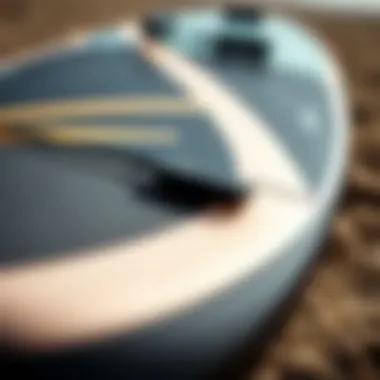
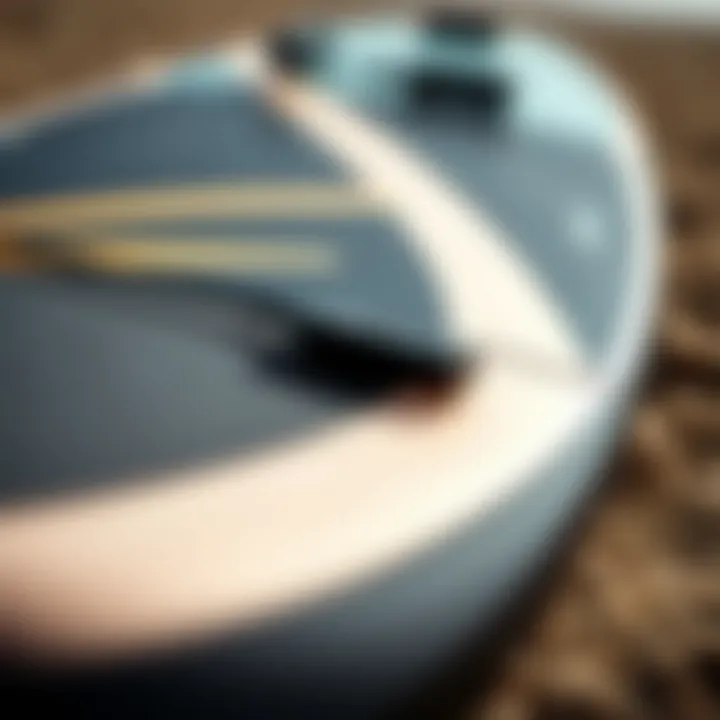
Twin-Tip Kiteboards
Twin-tip kiteboards are perhaps the most popular choice among kiteboarders, particularly for beginners and freestyle enthusiasts. These boards feature a symmetrical shape, allowing riders to ride in both directions without needing to turn the board around. The versatility of twin-tips makes them suitable for various conditions, from flat water to choppy waves.
Benefits of Twin-Tip Kiteboards:
- Easy Riding: The balanced design makes it easier to learn the ropes, offering stability that camaraderie lacks in other board types.
- Freestyle Friendly: Riders can perform tricks and jumps more easily due to the board's ability to switch directions without penalty.
- Wide Range of Sizes: With numerous options available in terms of size, riders can select a board that matches their weight, skill level, and riding style.
However, there’s a catch; twin-tips typically don’t handle choppy water as gracefully as some other types. If your local spot is known for rough conditions, you might find yourself longing for something more specialized.
Directional Kiteboards
Directional kiteboards are designed with a specific riding style in mind, often aimed at wave riding and those who enjoy the sensation of carving turns. These boards are asymmetrical, with a defined nose and tail, making them more streamlined for riding in one direction.
Characteristics of Directional Kiteboards:
- Nose and Tail Design: The shape of the board supports better control when navigating waves, allowing for more agile turns and smoother rides.
- Ideal for Waves: Riding in ocean swells, these boards shine due to their ability to cut through water and maintain speed.
- Carving Capabilities: Directional boards offer smooth transitions and the ability to execute wide turns, which many riders find exhilarating.
Nevertheless, this board type may not be the best fit for beginners. The learning curve can be steeper, as riders must adapt to consistently riding in one direction. A new kiteboarder may miss the versatility that a twin-tip provides.
Foil Boards
Foil boards represent a unique intersection of kiteboarding and hydrofoiling technology. These boards have a hydrofoil mounted below the board, allowing them to lift above the water surface. Riding a foil board feels quite different as it glides seamlessly, often providing a sensation akin to flying.
Advantages of Foil Boards:
- Reduced Drag: The hydrofoil decreases water resistance, thus allowing for quicker speeds and a more efficient ride even in lighter winds.
- Smooth Rides: With the board elevated, you experience fewer bumps from rough water, making it a comfortable choice.
- Less Obsession over Wind Conditions: Foil boards tend to perform well even when the wind is soft, which can lead to more time on the water in otherwise marginal conditions.
However, mastering foil boarding can take time and practice. Balancing while the board is lifted adds an extra layer of complexity, making it a better fit for those with some prior experience.
Ultimately, choosing the right kiteboard is fundamental to an enjoyable experience on the water. Understanding the distinctions between twin-tip, directional, and foil boards empowers you to select the option aligned with your riding style, skills, and the conditions in which you plan to ride. An informed choice today enhances the thrills of tomorrow's sessions on the water.
Key Features to Consider
Choosing the right kiteboard is not just about aesthetic appeal or the trendiest model on the beach. It requires a thoughtful examination of the important features that fuel performance and comfort on the water. The right specifications can transform an uncomfortable session into a thrilling experience while helping riders hone their skills at any level. This section will delve deep into the essential attributes every rider should evaluate when selecting a kiteboard.
Board Size and Shape
Volume and Length
Volume and length play critical roles in the efficiency and usability of a kiteboard. The volume of the board determines how buoyant it is, fundamentally affecting how the rider interacts with the water. A board with a larger volume provides better floatation, which is beneficial for beginners who might not have mastered their balance just yet. Most experts tend to recommend boards around 140 to 160 centimeters for novice riders. This length enables smoother rides, allowing newcomers to gain confidence and stability before venturing into more challenging terrain.
On the flip side, advanced kiteboarders seeking speed and agility may prefer shorter boards. These boards can execute sharper turns and maneuvers, catering to a more performance-oriented style. However, this comes at the expense of stability—something to keep in mind when searching for a board that matches your current skill level.
"Choosing the right volume and length can mean the difference between feeling like a fish out of water and gliding effortlessly across the waves."
Rocker Design
Next up is rocker design, another vital feature that impacts ride quality. The rocker refers to the curve of the board from tip to tail and can influence how smoothly a board cuts through waves. A board with a pronounced rocker will excel in choppy conditions, providing a cushioned ride as it absorbs the impact of waves. This characteristic makes it popular among riders who favor freestyle or wave riding.
Conversely, a flatter board is usually quicker when going straight. It's a choice preferred by speed enthusiasts and those wanting to cover long distances. Yet, this design may not perform as well in rough waters, potentially leading to a bumpy experience. Understanding the rocker design in relation to your preferred riding style will inform your choice, ultimately enhancing your overall kiteboarding experience.
Materials and Construction
Wood vs. Composite
When it comes to materials, the debate often centers on wood vs. composite constructions. Wooden boards typically provide a reponsive feel, allowing greater flex and feedback from the riding surface. This can be particularly enjoyable for recreational riders who appreciate a more tactile connection to the water. The natural materials also tend to absorb more vibrations, which can add a level of comfort during long sessions.
On the other hand, composite boards, often made from materials like fiberglass or carbon fiber, are favored for their durability and lightweight nature. They tend to withstand wear-and-tear better than wooden boards, making them a sound investment for enthusiastic riders. However, the trade-off might be a stiffer flex, leading to more jarring impacts. For those who ride aggressively or at higher skill levels, the benefits of a composite board usually outweigh those of a wooden alternative.
Durability Considerations
The longevity of the kiteboard is paramount. Durability considerations encompass the materials, construction techniques, and the rider's environment. Do you primarily ride in harsh conditions or a more mellow locale? A board designed to withstand tough waters typically has extra reinforcements, making it ideal for those challenging sessions when conditions are rough.
In addition to the construction material, also keep an eye on the quality of manufacturing. Boards that feature well-engineered designs and high-quality finishes will naturally stand the test of time. Doing a bit of homework on the brand's reputation for durability can save you from some nasty surprises down the line. It's worth investing in a kiteboard that will last for many memorable rides.
Performance in Different Conditions
Understanding how kiteboards perform in varying conditions is fundamental to making an informed choice. Different environments can change the dynamics of kiteboarding, affecting board selection, riding style, and overall experience. It’s crucial for both beginners and experienced riders to grasp these influences to enhance safety and enjoyment.
Choosing the right kiteboard isn’t just about personal preference; it’s also about the conditions you’ll be riding in. Whether it’s flat water or choppy waves, the performance of the kiteboard can significantly change how the rider interacts with the water.
Key benefits of understanding performance in different conditions include:
- Safety: Knowing how your board reacts can help you avoid mishaps.
- Enhanced Skill Development: Tailoring board choice to conditions enables riders to improve their technique.
- Optimized Enjoyment: Selecting a board that complements the environment allows for a more pleasurable experience.
Flat Water Riding
Flat water environments offer an ideal setting for kiteboarders who are either learning or looking to refine their skills. In these calm conditions, the water appears smooth, providing a steady surface for maneuvering without interference from waves. Kiteboards designed for flat water typically have a certain shape and construction that enhances their performance in these settings.
- Benefits of Flat Water Riding:
- Easy Progression for Beginners: Newcomers can focus on mastering their balance and control without worrying about choppy waves.
- Speed and Efficiency: Riders can achieve faster speeds due to minimal resistance, making it easier to practice jumps and tricks.
- Greater Stability: Boards with less rocker and a flatter base provide smoother landings, essential for those learning how to kiteboard.
Many flat water enthusiasts lean towards a twin-tip kiteboard due to its versatility, allowing for riding in either direction with ease. Additionally, a wider board can provide more surface area, boosting stability while riding at high speeds. If conditions are particularly calm, ensuring that you have a kite that’s suitable for low winds can make all the difference.
Choppy Water and Waves
When it comes to riding in choppy conditions or waves, the selection of a kiteboard must align with the forces of nature at play. Riders face challenges posed by wave action, wind shifts, and water texture. Board designs for these conditions focus on flexibility and responsiveness to ensure the rider maintains control and can handle unpredictable situations.
- Challenges in Choppy Conditions:
- Increased Turbulence: Choppy water can lead to sudden changes in board movement, which can destabilize the ride.
- Waves: Riding over waves requires a board that can absorb shocks and cut through the water effectively.
Kiteboards built for these conditions often feature a more pronounced rocker which helps to lift the nose of the board, maintaining speed even as the water rises and falls. Directional boards are particularly favored for wave riding as they enhance control and allow for precise navigation over the swells.
To sum up, the environment is essential in choosing the right kiteboard. Flat water offers an excellent starting point for beginners, while choppy waves demand boards designed for agility and stability.
"Picking a kiteboard that aligns with your riding conditions can mean the difference between a joyful experience and a struggle against the elements."
Ultimately, being mindful of the conditions under which you plan to ride informs your choice of gear, ultimately enhancing your skills and enjoyment in the sport.
User Experience and Preferences
When it comes to kiteboarding, the nuances of user experience and preferences play a crucial role. Each kiteboarder comes to the sport with their own set of skills, goals, and riding styles. Understanding these elements is essential for selecting the right equipment. It’s not just about the brand or price tag; it’s about how well the kiteboard fits with the rider’s unique approach to the water.
Everyone's journey starts somewhere. For beginners, the experience can be a bit rocky. They might be more focused on stability and ease of use rather than high performance. It's vital to choose a board that helps ease them into the rhythm of kiteboarding. A user-friendly board, such as a wider twin-tip kiteboard, allows them to feel more secure as they learn the ropes of kite control and body positioning. This added stability is a confidence booster, encouraging new riders to up their game and explore further as their skills develop.
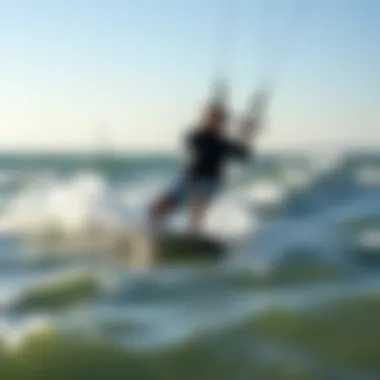

For more seasoned kiteboarders, preferences shift quite a bit. They often seek out boards that allow for more refined techniques and higher performance. The thrill of riding in different conditions, from flat water to challenging waves, demands boards with particular characteristics that cater to their advanced skills. These riders will have a clear understanding of their needs: they want lightweight materials and boards that allow for quick maneuvering and tricks. Notably, they might lean towards directional kiteboards when tackling waves, as these boards facilitate smoother, more controlled rides.
"The right board can transform your overall experience on the water. Understand your needs, and the rest will follow."
In summary, user experience and preferences shape the kiteboarding journey profoundly. As the sport continues to evolve, community insights highlight these variations more than ever. Platforms like Reddit and various kiteboarding forums serve as crucial resources to share experiences and recommendations. Riders can discuss what worked for them and what didn’t, facilitating learning and improvement for a wide range of skill levels.
Whether it’s the thrill of pulling off a new trick or the joy of carving through ocean waves, your individual experience will guide your decisions. Lay the groundwork for your kiteboarding journey by considering your personal riding style and preferences; this will lead to not just selecting the right board but enhancing your overall enjoyment of this exhilarating sport.
Beginner Considerations
For beginners entering the kiteboarding scene, the choices can feel overwhelming. With countless options on the market, settling on the right kiteboard is vital for ensuring a positive introduction to the sport. Look for kiteboards designed specifically to suit newcomers. Typically, these boards boast features that prioritize stability and forgiveness, allowing less experienced riders to focus more on learning rather than battling the board itself.
A wider board can provide more surface area, which in turn means better floatation and stability during maneuvers. This is particularly appealing for those just starting, as it can make learning to ride much easier. Additionally, boards with a softer flex allow for smoother landings and more controlled rides, serving well for those who might be hesitant about taking bold leaps.
It’s also worth considering the style of board. Twin-tips, known for their versatility, are perfect for beginners who are still figuring out their preferences. These boards can be ridden either direction, so learning to switch stance becomes less of a hurdle. With features focused on enhancing user comfort, these boards promote quicker learning curves and, ultimately, a more enjoyable experience.
Advanced Riders’ Needs
On the other hand, advanced riders have a different set of priorities when it comes to selecting a kiteboard. For these seasoned individuals, purpose and performance steer their choices. They often seek boards that push the limits of their skills and allow them to tackle a wider range of conditions with finesse.
Key attributes like a shorter length and stiffer flex cater to these riders who are looking to unlock their potential. These kinds of boards might be more responsive, leading to enhanced speed and agility—qualities that are essential for executing complex tricks and maneuvers. It’s a balancing act of ensuring the board aligns with their performance goals without compromising comfort during the ride.
Directional boards, popular among advanced riders, specially designed to handle bigger waves offer a level of control and performance that can transform the riding experience. They allow for sharper turns and effortless carving, particularly in turbulent conditions where a bit of extra agility comes into play.
Moreover, seasoned riders are usually more conscious of the materials used in their kiteboards. Preference often leans towards lighter, high-performance composites that enhance speed and reduce drag. But beyond performance, durability becomes a factor too; they need gear that can withstand the rigors of intense riding without falling apart after a few sessions. So, as they explore gear options, expert recommendations can be invaluable. Going through reviews and networking with the kiteboarding community helps solidify their choices.
In wrapping up this section, the balance between user experience, preferences, and individual needs is central to kiteboarding. While beginners may prioritize stability and user-friendliness, advanced riders seek performance-driven designs that elevate their skills to the next level. Understanding this landscape is essential to crafting an enthusiastic, engaging journey on the open water.
Comparative Analysis of Top Brands
Understanding the landscape of kiteboarding brands is crucial for any enthusiast looking to invest in gear. A comparative analysis of these brands can help you decipher which options stand out in terms of quality, performance, and user satisfaction. Each brand usually brings its own flavor, be it in innovation, durability, or price point. As kiteboarding grows in popularity, so does the number of brands vying for attention. Evaluating these can guide beginners and seasoned riders alike towards selections that align with their specific needs.
Benefits of Comparing Brands:
- Quality Assurance: Knowing which brands are reputable can save you a headache later on.
- Performance Metrics: Different brands excel in various conditions; understanding this can help you choose the right board for the right environment.
- Cost Effectiveness: It’s important to balance quality with what you’re willing to spend. Some brands may offer premium products that justify a higher price tag, while others provide great value for beginners.
In this section, we dive into three top brands, examining their unique attributes.
Brand A Overview
Brand A has carved its place in the kiteboarding world through years of experience and innovation. Mainly known for their high-performance boards, they focus on utilizing advanced materials and cutting-edge design techniques. Many users rave about the versatility of these boards, making them suitable for a range of conditions, from flat water to wavy setups.
One hallmark of Brand A’s offerings is their attention to user feedback, allowing them to fine-tune their products according to real-world riding experiences. This responsiveness contributes to a loyal customer base, as riders feel connected to the brand’s ongoing improvements and innovations. Their boards are widely regarded for their control, making them a solid option for both beginners who are finding their footing and advanced kiteboarders seeking adrenaline.
Brand B Review
Brand B takes a different approach by prioritizing the balance of affordability and quality. Their boards tend to be more budget-friendly while maintaining a high standard of construction. Riders often note that Brand B's products are particularly forgiving, which makes them ideal for those just starting out on their kiteboarding journey.
The designs are intuitive for novice users, who might struggle with more complex equipment. However, seasoned riders can also find value in Brand B’s range. Some models are designed specifically for freestyle riders, incorporating features that allow for higher jumps and sharper turns.
This brand has won a strong following thanks to its solid warranty and good customer support, giving riders peace of mind when making a purchase.
Brand Insights
With a different flair, Brand C emphasizes sustainability without sacrificing performance. Their boards are made from eco-friendly materials, reflecting increasing consumer interest in sustainability in all aspects of life, including adventure sports. This manaer gives them a unique selling point in a crowded market.
Riders who choose Brand C often highlight the smooth ride and remarkable stability these boards offer. This makes them particularly appealing for users who often face variable conditions. Brand C is continuously pushing the envelope with its designs, ensuring that even those who are passionate about performance do not have to compromise on their values.
Expert Recommendations
Expert recommendations serve as a beacon for kiteboarders, helping them navigate the often overwhelming choices in gear selection. This section highlights the recommendations from seasoned professionals who not only ride but also understand the nuances behind different gear options. These insights are vital for anyone seeking to elevate their kiteboarding experience. By considering the advice from experts, riders can make informed choices that align closely with their individual preferences and riding styles.
Professional Rider Insights
Professional riders bring years of experience, often honed in diverse conditions and styles of kiteboarding. Their insights can be incredibly helpful. They focus not just on personal preferences but also on general trends observed in the industry. For instance, many professionals emphasize the importance of selecting a kiteboard that not only matches one's skill level but also complements the choice of kite. Here are a few key takeaways from their wisdom:
- Balance and Control: Riders often suggest that beginners look for boards that provide better balance and control, such as twin-tip designs. This facilitates learning basic maneuvers like jumping and turns with greater ease.
- Size Matters: Professionals indicate that board size is crucial; larger boards might be beneficial for lighter wind conditions, while smaller boards tend to excel in stronger winds. The right size can make a world of difference in performance and comfort.
- Testing is Key: A common theme among pro riders is the encouragement to test various boards before making a purchase. Many brands offer demo days or rent boards, allowing users to feel the nuances across different models.
Instructor Tips
Instructors play a pivotal role in shaping the skills of budding kiteboarders. Their guidance is not only about technique but also about safety and gear selection. Here are some recommendations they often share with their students:
- Start Simple: For novices, it is always best to begin with simpler gear. Instructors recommend avoiding high-performance boards initially, as they might lead to unnecessary frustration. A forgiving initial experience lays a strong foundation for future progress.
- Frequent Maintenance: Instructors stress the importance of taking care of your kiteboard to prolong its lifespan. Regular checks for damage, ensuring straps are secure, and keeping the board clean can prevent mishaps.
- Know Your Spot: Locations vary significantly; the choice of a kiteboard should take into consideration the specifics of the riding area. Instructors often assess local conditions and suggest gear based on wind patterns and water state.
Ultimately, leveraging expert recommendations can significantly enhance one’s kiteboarding journey. The insights from both professional riders and instructors play a crucial role in ensuring that every decision aligns with user skill levels and local riding conditions. This tailored approach to gear selection empowers riders to have safer and more enjoyable experiences in the water.
Maintenance and Care of Kiteboards
Proper maintenance and care of kiteboards is not just a chore; it’s a cornerstone of ensuring longevity and enhancing performance. Kiteboarding gear can face serious wear and tear due to exposure to saltwater, sun, and constant impact. A well-maintained kiteboard not only rides better but also safeguards the investment made into this sports activity. This section underscores some pivotal aspects of maintenance and care, focusing on practical strategies that can make a significant difference over time.
Cleaning Techniques
Keeping your kiteboard in top shape starts with effective cleaning techniques. After each session, take a moment to rinse off your board thoroughly with fresh water. This seemingly small act has big benefits, as it helps to remove salt residue and sand that can wear down the surface and affect performance.
Here are some practical cleaning tips:
- Rinse Immediately: After kiteboarding, rinse your board with fresh water. Make it a habit as soon as you get off the water.
- Use a Soft Cloth: While rinsing, use a soft, non-abrasive cloth or sponge to wipe away any stubborn debris. Avoid rough materials that might scratch the surface.
- Inspect for Damage: Take the time to inspect your board for any small cracks or dings. Catching these early can save plenty of headaches down the line.
- Drying: Allow your board to dry completely before storing it away. Moisture trapped in storage can lead to mold or unwanted odors.
"A clean kiteboard rides smoothest; neglect leads to regret."
Storage Recommendations
Where and how you store your kiteboard is just as integral as how you clean it. Proper storage can extend the life of your board by protecting it from environmental factors. To ensure your kiteboard remains ready to perform, here are a few tips to consider:
- Cool, Dry Place: Store your board in a cool, dry environment away from direct sunlight. Excessive heat can warp the materials over time, while humidity can foster mold or mildew.
- Use a Bag: Invest in a quality board bag, which can provide protection from impacts and abrasions during transport. Many boards come with padded bags specifically designed for this.
- Vertical Storage: If possible, store the board vertically or flat, rather than leaning against a wall. This minimizes the chances of warping.
- Avoid Heavy Loads: Never stack heavy items on top of your kiteboard, as this can cause deformation that could affect performance.
Overall, proper maintenance and care of kiteboards is essential for ensuring optimal performance and extending the lifespan of your gear. With diligent cleaning habits and smart storage practices, kiteboarders can enjoy the sport with confidence and peace of mind.
Safety Considerations
In the exhilarating world of kiteboarding, the thrill of riding the waves can often overshadow the vital importance of safety. Understanding safety considerations is not just a checklist; it is paramount for ensuring an enjoyable and accident-free kiteboarding experience. Every rider, whether novice or expert, should make safety a priority to minimize risks and enhance their adventures. By learning about safety gear and local regulations, you can protect yourself and others, setting the tone for a positive journey on the water.
Wearing Safety Gear
The role of safety gear in kiteboarding cannot be overstated. Just like a chef wouldn't enter the kitchen without a sharp knife or a flameproof apron, kiteboarders should equip themselves with the necessary protective wear. Here’s a rundown of critical gear:
- Helmet: A sturdy helmet not only safeguards against head injuries, but it also affords some warmth when riding in cooler waters.
- Impact Vest: This vest serves a dual purpose: it cushions impacts during crashes and provides buoyancy, a lifesaver in case of an unexpected tumble.
- Wetsuit: A wetsuit protects against abrasions and keeps you warm. Depending on the water temperature, it can be a thin shorty or a thicker full suit.
- Leash: The leash connects you to your kiteboard and plays a crucial role in preventing runaway equipment, which can lead to collisions or entanglements.
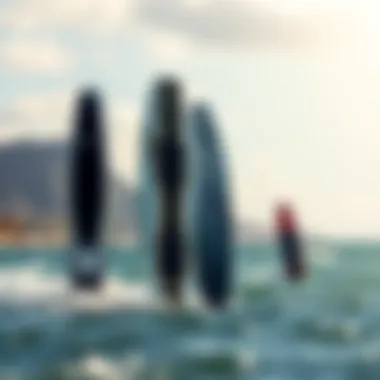
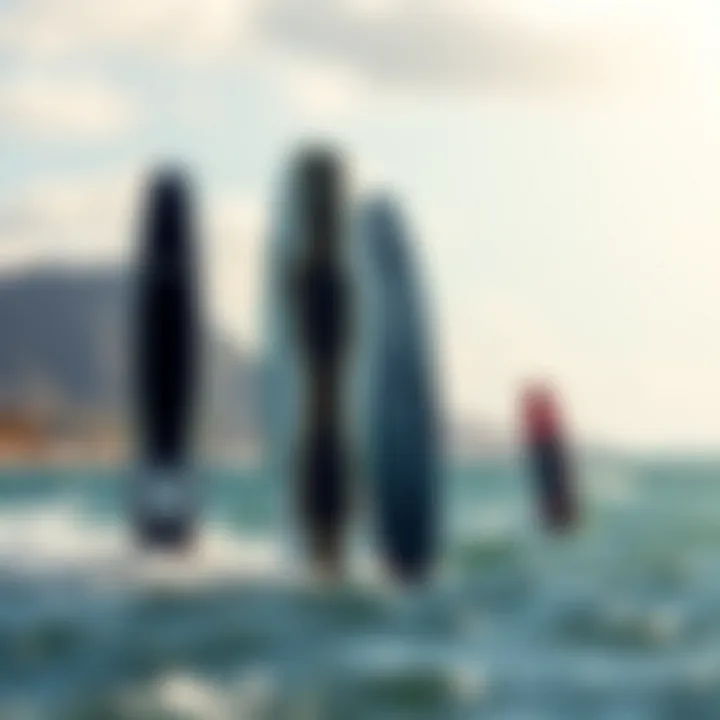
The benefits of wearing this gear are multifaceted. First off, they minimize injury risk, enabling you to focus on mastering your skills. Furthermore, it instills confidence, allowing you to push your limits safely. Always check your gear before heading out; the last thing you want is a faulty buckle or frayed straps when you’re catching air.
Understanding Local Laws
When it comes to kiteboarding, understanding the local laws is more than just following rules; it’s about respecting the environment and ensuring a harmonious coexistence with other water users. Each locale can have rules governing kiteboarding, particularly concerning where and when you can ride. Ignoring these regulations can result in citations or, worse, accidents.
- Permitted Areas: Familiarize yourself with designated kiteboarding spots. Some beaches may prohibit the sport altogether or restrict it to specific times.
- Distance Regulations: There may be rules about maintaining distances from swimmers, surfers, and each other to prevent collisions.
- Environmental Protection: Many regions enforce guidelines to protect wildlife, such as nesting areas for birds or coral reefs. Adhering to these rules benefits everyone.
"The ocean is life. Protecting it is paramount for future generations of thrill-seekers.” – Unknown
Ultimately, being knowledgeable about local laws encourages a culture of safety and responsibility.
In summary, safety considerations in kiteboarding encompass the wearing of appropriate gear and the understanding of relevant laws. Taking these aspects seriously fosters a more enjoyable environment for everyone involved in the sport. By prioritizing safety, you can embark on your kiteboarding adventures with assurance and peace of mind.
Exploring Kiteboarding Destinations
Kiteboarding is not just about mastering the art of riding; it’s also about the thrill of adventure in incredible locations. Exploring the world’s best kiteboarding destinations is essential for both novice and seasoned kiteboarders. Each place offers distinct conditions, breathtaking views, and unique experiences that can greatly enhance your time on the water. Whether you're looking for smooth water or powerful waves, choosing the right destination is crucial for optimizing your kiteboarding escapades.
The significance of these locations cannot be overstated. They serve as venues for skill development, competition, and leisure, catering to the kiteboarding community by providing safe and challenging environments. Additionally, each destination can also help you connect with fellow enthusiasts, fostering a sense of community that's integral to the sport.
Top Locations Worldwide
When it comes to kiteboarding, some spots have earned a reputation that transcends geographical boundaries. Here’s a look at a few renowned kiteboarding locations:
- Maui, Hawaii: Known for its consistent winds and beautiful waters, Maui is often seen as the kiteboarding mecca. Spots like Kanaha Beach provide ideal conditions for all levels, from novice to pro, amidst stunning scenery.
- Cape Town, South Africa: With the iconic Table Mountain as its backdrop, the winds in Cape Town are strong and reliable, making it a hotbed for kiteboarders. Locations like Kite Beach are often bustling with enthusiasts.
- Tarifa, Spain: Often dubbed the "Wind Capital of Europe," Tarifa attracts kiteboarding fans for its powerful winds and ample spots. The vibrant local culture means there's always something happening off the water too.
- Cumbuco, Brazil: This hidden gem offers warm water and steady winds nearly year-round. With a laid-back atmosphere, Cumbuco is perfect for those looking to soak up both sun and surf.
The key to a successful kiteboarding trip is knowing more than just the wind directions. Understanding local customs, seasonality, and potential hazards is equally important.
Local Hotspots for Beginners
For those just starting their kiteboarding journey, finding the right local hotspot is a vital step. Here are some beginner-friendly locations that offer excellent learning conditions:
- Kite Beach, Dominican Republic: This beach is famed for its shallow waters and consistent breeze, making it ideal for learners. Nearby schools provide excellent instruction and rental equipment.
- Long Beach, New York: A great spot for those living in the Northeast U.S. Trainers and equipment rentals are easily found here, and the beaches are spacious, allowing for plenty of practice without congestion.
- Sandy Hook, New Jersey: With its relatively flat waters and steady winds, Sandy Hook is a safe choice for newbies. The local community of kiteboarders is welcoming, often eager to share advice.
- Kitesurfing Centres in Boracay, Philippines: Boracay’s captivating beaches not only offer clear waters but also specialized kiteboarding schools catering to beginners all year round.
Choosing a destination is just as critical as picking the right board or gear. Each of these places ensures that beginners have the support and conditions they need to grow and have fun in a safe environment.
"The beauty of kiteboarding isn’t limited to the sport itself but extends to the spectacular locations that it takes you to."
To wrap it all up, the right destination can significantly impact your overall kiteboarding experience. Learning about each location’s wind conditions, safety measures, and community can make your kiteboarding journey much more enjoyable and rewarding.
User-Generated Content and Community Features
In the world of kiteboarding, the significance of user-generated content and community features cannot be understated. Not only do they cultivate a sense of belonging amongst enthusiasts, but they also serve as invaluable resources for both novice and experienced riders. By sharing personal experiences and insights, kiteboarders can learn from each other, fostering a rich tapestry of knowledge that enhances the sport's culture.
Integrating user-generated content into the kiteboarding community offers several benefits. First, it creates a platform for individuals to showcase their journeys, trials, and triumphs. This not only inspires others but also provides real-life examples of various techniques and equipment in action, making the information more relatable and practical. Such content often reflects a diverse range of experiences, revealing multiple perspectives on approaches to kiteboarding.
Second, community engagement through forums and discussion boards allows for the exchange of ideas and solutions in real-time. Questions about equipment, riding techniques, and local conditions can be posed and answered almost instantly, leading to a more informed community. The immediacy of this dialogue helps individuals make better decisions in their kiteboarding endeavors, especially when trying out new gear or traveling to unfamiliar locations.
Sharing Personal Experiences
When kiteboarders share their personal experiences, they contribute to a treasure trove of knowledge that is often more relatable than traditional tutorials or manuals. Each story encapsulates unique lessons learned, whether it's mastering a specific trick, dealing with a challenging weather condition, or understanding how to care for their gear. For example, a post detailing how a rider improved their jumping technique through trial and error can provide insights that resonate deeply with those looking to enhance their own skills.
Moreover, the authenticity of these narratives builds a synchronicity within the kiteboarding community. The vulnerabilities shared in these stories foster camaraderie, as readers can empathize or even find solace in similar struggles. Social media platforms and specialized kiteboarding websites serve as excellent mediums for these stories, whether they be blog posts, Instagram reels, or video tutorials on YouTube.
"The beauty of kiteboarding lies not only in the thrill of the ride but in the experiences we share that guide one another in our journeys."
Forums and Discussion Boards
Forums and discussion boards play a critical role in nurturing communication among kiteboarders. They encourage discussions on a wide array of topics, ranging from gear recommendations to travel advice. The collaborative nature of these platforms means that anyone can jump in and offer their two cents, whether it’s a seasoned pro or someone just starting out.
Popular platforms like Reddit’s r/Kiteboarding and specialized sites like KiteForum.com provide excellent spaces for kiteboarders to congregate. Here’s what makes them particularly beneficial:
- Real-Time Help: When members post questions, they often receive quick responses. A rider facing difficulties with a specific maneuver can get instant tips from others who encountered similar issues.
- In-Depth Product Discussions: The ability to explore user reviews and ratings of specific brands or models of kiteboards enriches the decision-making process. Riders can weigh functionality against budget based on real experiences, leading to more informed purchases.
- Safety Advice: Knowledge about safety gear and practices is essential for all levels of kiteboarding. Community members often share personal anecdotes or lessons learned, which can be crucial for avoiding dangers.
- Localized Info: For those traveling, community forums often provide recommendations for the best local spots or conditions. Essentially, they serve as guides that unveil hidden gems to explore.
In essence, user-generated content and community features are lifelines in the kiteboarding ecosystem. They not only build a rich archive of shared wisdom but also enhance the overall experience by bringing together people from diverse backgrounds, united by their love for the sport.
Kiteboarding Events and Competitions
Kiteboarding isn’t just a thrilling sport; it’s a community that thrives on connection, competition, and inspiration. Participating in kiteboarding events and competitions provides riders with a unique chance to showcase their skills, meet like-minded individuals, and immerse themselves in the sport's culture. For both novices and seasoned pros, understanding the events on offer can enhance the overall kiteboarding experience.
These competitions often act as a testing ground for the latest equipment, techniques, and innovations. They serve as platforms for brands to unveil new gear, creating a symbiotic relationship between manufacturers and the athletes who push their products to the limits. Furthermore, events foster camaraderie among kiteboarders, providing opportunities for networking and along with a healthy sense of competition, which can push everyone’s skills to new heights.
With various categories ranging from freestyle to race and wave, there’s something for everyone. Riders can find a place that suits their style and location preference.
Overview of Major Events
A variety of renowned kiteboarding events occur across the globe, exhibiting the sport's dynamic nature. Major competitions include the following:
- The Red Bull King of the Air: This event is legendary in the kiteboarding world. It takes place in Cape Town, South Africa, and is famous for high-flying stunts and the impressive environment.
- The GKA Kite World Tour: A series of events held at stunning global locations. This tour encompasses different disciplines and showcases a blend of talent and technique.
- The KiteSurfing World Cup: Focused on waves and style, it provides a platform for top riders to shine in unique conditions.
- Local Competitions: Often organized by schools or clubs, these events serve as stepping stones for beginners and regional talents to gain exposure.
Each of these events not only emphasizes competition but also showcases the wide-ranging talents of kiteboarders and highlights local conditions and cultures.
How to Participate
For those looking to dive into the world of kiteboarding competitions, here’s a breakdown of how to get involved:
- Research Competitions: Start by identifying which events align with your skill level and interests. Many websites, such as GKA Kite World Tour, provide detailed information on upcoming events.
- Sign Up Early: Most events require early registration. Pay attention to deadlines and ensure all your paperwork is in order.
- Prepare Your Gear: Ensure your equipment is competition-ready. You might want to check local regulations regarding gear, especially if you’re traveling.
- Join a Community: Engage with local kiteboarding clubs or forums such as Reddit's Kiteboarding Community for tips, support, and connections.
- Attend Pre-Event Workshops: Many competitions offer workshops to hone your skills before the event. This can be invaluable in boosting confidence and performance.
- Show Up and Compete: Once you’re registered, attend the event, meet other competitors, and enjoy the experience, regardless of the outcome. Remember, every ride is a chance to learn.
Kiteboarding events and competitions provide an enriching backdrop for both personal growth and community bonding. Not only do they fuel passion, but they can also pave the way to numerous opportunities within the kiteboarding world.
Future of Kiteboarding
When discussing the trajectory of kiteboarding, one must consider the rapid evolution this sport has undergone in recent years. The future of kiteboarding isn't just about refining existing technologies or increasing participation rates; it encompasses a broader range of factors. The innovations we see today impact not just the gear, but also the way communities come together and how experiences are shared. The importance of this topic lies in its potential to inform and inspire both newcomers and veterans alike, making it an essential component of our comprehensive analysis.
Innovations in Technology
Technology is the heart of progress in kiteboarding. One can liken the transformation of kiteboards to the evolution of smartphones; just when you think they can't get any better, something revolutionary comes along. The past few years have seen remarkable advancements in materials and designs. For instance, the introduction of lightweight, durable carbon fibers has not only enhanced the responsiveness of modern kiteboards but has also increased their lifespan significantly. These materials are engineered to withstand the harshest of conditions, ensuring that kiteboards can endure countless sessions on the water.
Moreover, the development of smart kites that can adjust their flying characteristics based on conditions is creating a buzz among enthusiasts. These kites utilize sensor technology to analyze wind speed, allowing riders to experience optimal performance without manually adjusting settings.
"The future holds promises of a more intuitive, dynamic kiteboarding experience, merging technology with the thrill of the sport."
While these technologies come with a price tag, the value added in terms of performance is undeniable. Riders looking for an edge will appreciate how these innovations can fine-tune their capabilities.
Sustainability Trends
The conversation around sustainability is not a new one, yet its relevance in kiteboarding is increasingly significant. As awareness grows, the kiteboarding community starts to question the environmental impact of their activities, fostering an emerging trend towards eco-friendly practices. From kiteboards crafted from recycled plastics to biodegradable materials, the industry is witnessing a paradigm shift.
Many brands are paving the way by investing in sustainable production methods. This means minimizing waste and focusing on materials that don’t contribute to environmental degradation. Initiatives such as carbon offset programs are also gaining traction, allowing riders to balance their CO2 footprints while enjoying the sport.
In addition, local communities are becoming advocates for cleaner waterways and coastlines. Kiteboarders are often at the forefront of beach clean-ups and environmental awareness campaigns. By fostering a community that values ecological responsibility, the future of kiteboarding not only looks exciting but also ensures that the sport remains viable for the generations to come.
Embracing these sustainability trends not only benefits the environment but positions kiteboarding as a forward-thinking sport, appealing to those who not only seek adventure but also care about the planet.









